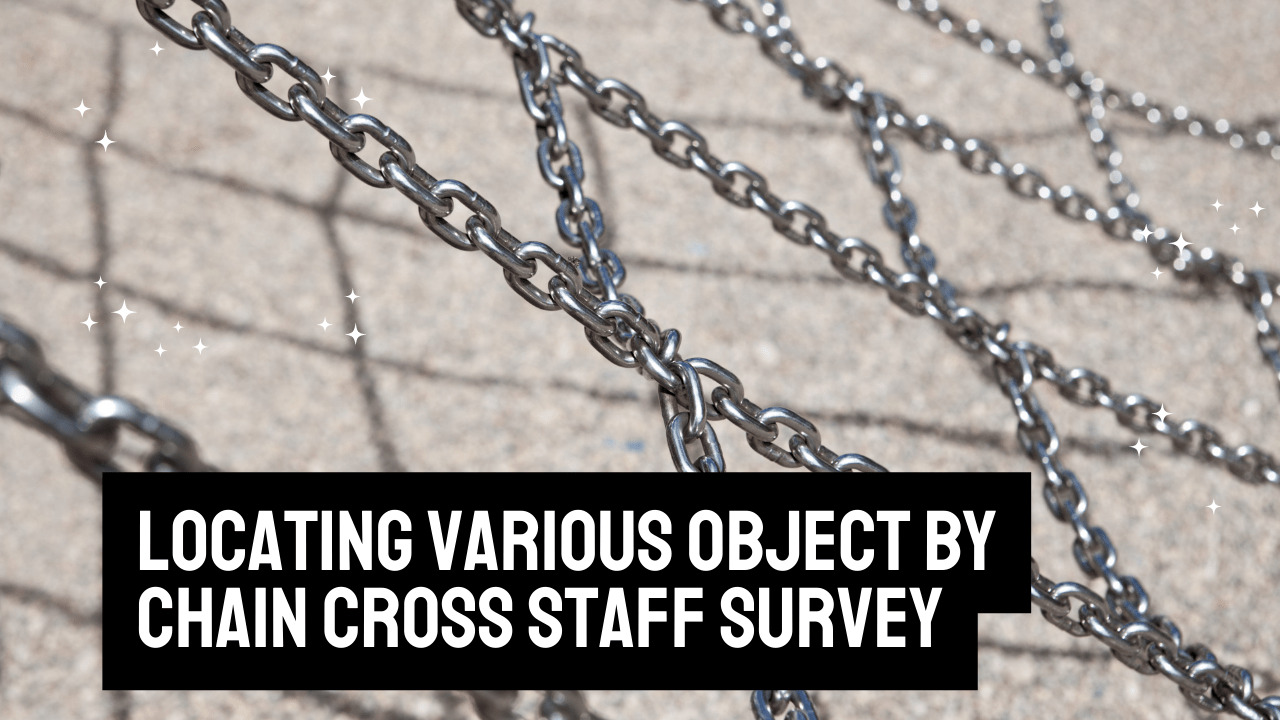Table of Contents
Objective:
The primary objective of this job is to locate various objects in the field by chain and cross-staff.
Apparatus:
- Two chains
- Arrows
- Ranging rods
- Cross staff
- Plumb bob
Least count of the instrument:
Least count of metric chain = 0.02 m
Related theory:
Chain survey
Chain survey is the most vastly used in surveying because of its convenience and ease. It is used in performing a reconnaissance survey to get a rough idea of the site location. The chain contains 100 or 150 parts of galvanized mild steel, having a diameter of 4 mm termed links.
The ends of the link are bent to shape in a loop and are joined by three oval rings. The chain ends have handles for controlling the chain on the ground. Each wire has a swivel joint so that the chain can be manipulated during its use without twisting. The length of the chain is measured between the end handles.
Chain surveying is very useful when the surveying field is leveled and plans are required on a large scale e.g., fields. Chain surveying is very accurate for areas of a small extent.
Types of chains
- Metric chains
- Gunter’s chain or surveyor’s chain
- Engineers chain
- Revenue chain
- Steel band or Band chain
Uses of chain survey
Chain survey has many uses such as:
- Reconnaissance survey
- Selection of station
- Length measurement
- Taking offsets
Cross-staff
The cross-staff is a simple instrument that is widely used in surveying operations. It is suitable for setting out right angles on a required survey line. It has three types:
- Open cross-staff
- French cross-staff
- Adjustable cross-staff
The most commonly use out of these is the open cross-staff.
1)Open cross-staff
The open cross-staff is made up of four metal arms having vertical splits in them. These two pairs of arms AB and BC are perpendicular to each other. The reason it contains vertical slits is to sight the object and the ranging rods.
The cross-staff is supported on top of a wooden pole of 2.5 cm diameter and 1.5 m in length. The end of the pole is connected with an iron shoe to help provide grip when it is placed on the ground surface.
2)French cross-staff
This instrument is made in octagonal shape and contains an octagonal brass tube with slits on all its eight sides. It comprises an alternate vertical sighting slit and opposite vertical window as well.
It also has a fine vertical wire or horsehair on each of the four sides that are used for setting out perpendiculars.
It also has vertical slits on the other sides for setting out angles of 45 degrees. It holds a socket at the base to help it support on the pointed staff while using it in the field. French cross-staff is less accurate than an open cross-staff.
3)Adjustable cross-staff
It includes a brass cylindrical tube that is 1 cm deep and 8 cm in diameter. It is separated in half from the center. The top cylindrical part can be rotated relative to the bottom part utilizing a circular rack and pinion system actuated by a screw.
Both top and bottom cylindrical parts have sighting slits; the bottom part has graduations in degrees and sub-divisions while the top part carries a vernier scale. Thus, it can be used to set outlines of any desired angle. It also contains a magnetic compass mounted at the top to observe the bearings of the required survey lines.
Procedure:
- To locate the foot of the perpendicular from the object, hold the cross-staff roughly in position and keep one pair of slits in the direction of the ranging rod fixed at the forward end and the chain line.
- Look through the other pair of slits and see whether the specific object is bisected or not. If not, then move the cross-staff till the required bisection is obtained.
- Record the chainage of the foot of the perpendicular
- Take care to see whether one pair of slits is in the direction of the chain or not. During shifting the position of the cross-staff may get disturbed and hence precaution is necessary.
- To set a perpendicular to the chain line at a given point, orient one pair of slits towards the direction of the chain line by looking at the ranging rod fixed at the forward end by observing through the other pair of slits.
- The ranging rod is now fixed in the direction of the line of sight provided by this pair.
Observations & Calculations:
| Sr. No. | Station | Object | Chainage (meters) | Remarks |
| 1 | ||||
| 2 | ||||
| 3 |
Results & Discussions:
The locations of various objects have been successfully determined by chain and cross-staff in the field.
Important considerations:
- Run chain line parallel to the leveled ground, if possible.
- After use in rainy and humid weather, metal chains should be cleaned and dried and wiped with an oily cloth to prevent corrosion and rusting.
- A piece of colored cloth or ribbon should be tied to the arrow to make them easy to sight on the field.
- Ranging rods should be kept as vertical as possible at the station point.
- Note down the temperature, weather conditions, and time of day before initiating any survey operation.
- To check the accuracy of the fieldwork, the length of the boundary line may be measured directly using tape.
Precautions:
- Helmet, protecting shoes, and reflective vests must be worn by all field workers.
- All instruments used to carry out the survey must be handled cautiously.
- To avoid direct contact from, sunlight and rain, an umbrella should be used.
- Follow the proper stepwise procedure to avoid any errors.
- The bottom of the ranging rods should be placed on a clean and even ground surface.








